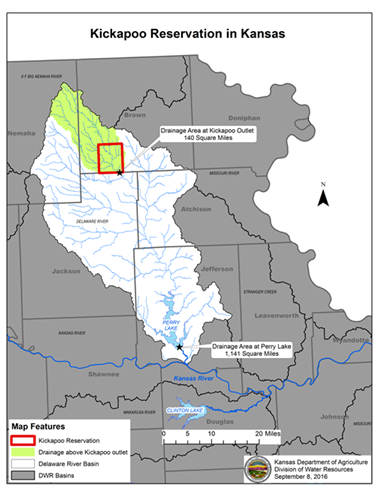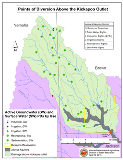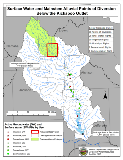Background
 Like other tribes, the Kickapoo Tribe of Kansas has a federal water right linked to the establishment of the reservation in 1832: federal reserved water rights were recognized by the U.S. Supreme Court in Winters v. United States (1908).
Like other tribes, the Kickapoo Tribe of Kansas has a federal water right linked to the establishment of the reservation in 1832: federal reserved water rights were recognized by the U.S. Supreme Court in Winters v. United States (1908).- The Tribe has been seeking to develop a more secure water supply for its current and future needs. Kansas, the Tribe, and the federal government cooperated for the purpose of building a reservoir to satisfy the Tribe's water rights, under the USDA's Small Watershed Program (1970s-1990s).
- Cooperation broke down over securing land necessary for the reservoir. The Tribe filed a lawsuit in June 2006 asking Kansas to condemn land and recognize the Tribal Water Right. The land issue was resolved by the Court in early 2014.
- The parties (Tribe, Kansas, U.S.A) agreed to suspend active litigation to negotiate a resolution.
- The Kickapoo Tribe Water Rights Settlement Agreement was signed on September 8, 2016. The agreement is the culmination of the negotiations.
- On February 13, 2017, the Tribal, State and Federal parties filed a Joint Stipulation for Dismissal of the litigation.
Summary of the Water Right Settlement Agreement
The Water Right Settlement Agreement establishes the nature, extent and characteristics of the Tribal Water Right and the respective rights, duties and obligations of other Parties. Under the agreement, the Tribe may divert or redivert, as available, up to 4,705 acre-feet of water per year with a priority date of October 24, 1832 for any direct use for the Tribe. Domestic use by members and Allottees does not count against the Tribal Water Right. Kansas domestic water rights are exempt from administration to protect the Tribal Water Right. The Tribe may store in one or more reservoirs, for the purpose of subsequent direct use, up to a combined volume of 18,520 acre-feet. The combined volume may be increased if seepage characteristics of the reservoir or reservoirs requires. Direct use and storage allowances of the agreement were determined based on municipal build-out concept, using methods consistent with the Kansas law for Kansas water users. This method was determined by both the State and Tribe to be superior to the traditional method of quantifying Tribal reserve water rights based on "practicable irrigable acreage". The Settlement Agreement includes an attached Memorandum of Agreement which establishes clear and transparent procedures for communication, monitoring and protection of the Tribal Water Right. The MOA provides for a process of annual reviews by the State and Tribe to insure it remains current, especially as the Tribe develops storage.
Under the Settlement Agreement, the Kansas Department of Agriculture - Division of Water Resources and the Chief Engineer have the following responsibilities:
- Agree to recognize the Tribal Water Right with a priority date of October 24, 1832
- Review applications of Kansas water rights to ensure prevention of injury to the Tribal Water Right and to provide notice of applications to the Tribe
- Monitor the basin as prescribed in the attached Memorandum of Agreement
- Respond to notices of impairment through evaluation and administration, as needed
- Review annually, with the Tribe, the Memorandum of Agreement to insure it remains appropriate as the Tribe develops its demand and constructs storage
Under the Settlement Agreement, the Kickapoo Tribe of Kansas has the following responsibilities:
- Construct and maintain dams and other water structures
- Provide the Chief Engineer copies of inspection reports and notice of signification changes in construction and operation, any structural problems of dams or reservoirs and proposed remedies, and any serious problems such as dam failure
- Enact a Tribal Water Code
- Meter all diversion and annually report water use
- Provide additional data required by the Chief Engineer to administer water rights to protect the Tribal Water Right
- Review annually, with KDA-DWR, the Memorandum of Agreement
What Kansas Water Rights are affected by the agreement?
- Kansas water rights subject to administration

- During times of shortage, when the Tribe is unable to meet its direct demands or when shortage is below target levels, the Tribe may request curtailment of upstream water rights. Upstream water rights include:
- Irrigation, 2
- Industrial, 4
- Recreational, 2
- Sediment control dams, 23
- Watershed dams will be required to bypass inflows, but not the release of water lawfully stored
- No administration of domestic use
- No administration if the Chief Engineer determines it would be "futile"
- Downstream water rights potentially affected

- As the tribe develops its water right, it will use and store water that formerly made its way downstream
- Few water rights are immediately downstream of the Reservation
- Maximum drainage area anticipated to be controlled by the Tribal storage would be less than 5% of the drainage area above Valley Falls
What happens from here?
Congressional review: Indian Water Settlement agreements require Congressional approval.